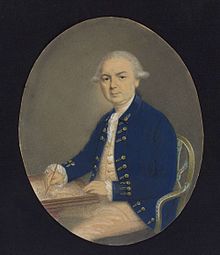Samuel Wallis
Samuel Wallis | |
|---|---|
 Portrait of Samuel Wallis by Henry Stubble, c. 1785 | |
| Born | 23 April 1728 Fentenwoon, Cornwall |
| Died | 21 January 1795 (aged 71) Devonshire Street, London |
| Allegiance | Kingdom of Great Britain |
| Service/ | Royal Navy |
| Years of service | c.1748–1795 |
| Rank | Captain |
| Commands held | HMS Swan HMS Port Mahon HMS Prince of Orange HMS Dolphin HMS Torbay HMS Dublin HMS Queen |
| Known for | Pacific exploration |
| Battles/wars | Seven Years' War American Revolutionary War |
| Spouse(s) | Betty Hearle |
| Other work | Extra Commissioner of the Navy |



Samuel Wallis (23 April 1728 – 21 January 1795 in London) was a British naval officer and explorer of the Pacific Ocean who made the first recorded visit by a European navigator to Tahiti.
Biography
Wallis was born at Fentenwoon Farm, near Camelford, Cornwall. He served under John Byron. In 1757, he was promoted to captain and was given the command of HMS Dolphin as commander of an expedition accompanied by Philip Carteret on HMS Swallow with an assignment to circumnavigate the globe.[1] As was reported in the press, he was also tasked with discovering the Southern Continent.[2] The two ships were parted by a storm shortly after sailing through the Strait of Magellan. In June 1767, the expedition made the first European landfall on Tahiti, which he named "King George the Third's Island" in honour of the King. Wallis himself was ill and remained in his cabin so lieutenant Tobias Furneaux was the first to set foot, hoisting a pennant and turning a turf, taking possession in the name of His Majesty. He described Tahiti as having a very good climate and the island being 'one of the most healthy as well as delightful spots in the world'.[3]
Dolphin stayed in
Following his return in England, Wallis was able to pass on useful information to James Cook, who was due to depart shortly for the Pacific, and some of the crew from the Dolphin sailed with Cook. Although Cook carried an official report of Wallis's circumnavigation, it is not known whether the two met prior to Cook's departure in August 1768.
In 1780, Wallis was appointed an Extra Commissioner of the Navy.
See also
Notes
- ^ a b c Quanchi, Historical Dictionary of the Discovery and Exploration of the Pacific Islands, p. 248
- ^ The Public Ledger and The Gazetteer, 5 July 1766.
- ^ John Hawkesworth, An Account of the Voyages Undertaken by the Order of His Present Majesty for Making Discoveries in the Southern Hemisphere, Chapter VIII, p. 313
References
- Glyndwr Williams, 'Wallis, Samuel (1728–1795)', Oxford Dictionary of National Biography, Oxford University Press, 2004; online edn, May 2005 accessed 10 Dec 2007
- Quanchi, Max (2005). Historical Dictionary of the Discovery and Exploration of the Pacific Islands. The Scarecrow Press. ISBN 0810853957.
- Hawkesworth, John; Byron, John; Wallis, Samuel; Carteret, Philip; Cook, James; Banks, Joseph (1773), An account of the voyages undertaken by the order of His present Majesty for making discoveries in the Southern Hemisphere, and successively performed by Commodore Byron, Captain Wallis, Captain Carteret, and Captain Cook, in the Dolphin, the Swallow, and the Endeavour drawn up from the journals which were kept by the several commanders, and from the papers of Joseph Banks, esq, London Printed for W. Strahan and T. Cadell, Volume I, Volume II-III
